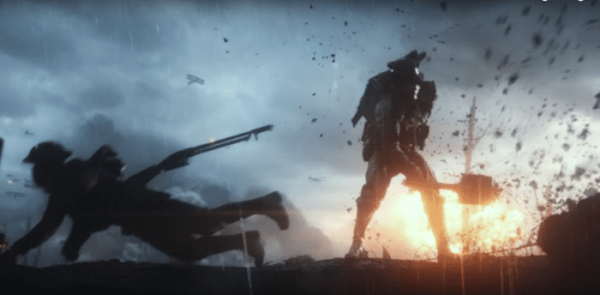Explosions go off all around, kicking up blood and mud to cake my screen. Panting blares through the speakers as buildings crumble under the weight of mortar blasts. The farm I’m on is slowly becoming a field of craters and trenches. Where crops once grew, bodies now lie strewn about. The only thing keeping me from becoming some sort of morbid fertilizer is my bayonet and my wits. No modern technology, not jet or chopper to whisk me away, no computers to pinpoint where my enemies lie in wait. This is World War 1 in Battlefield 1, and it is the biggest evolution I have every experienced in the series.
At first, I felt a bit hesitant to use the word ‘evolution’. To many, removing all modern technology from a game about warfare would be more akin to devolution. Stripping features, removing lasers, thermal vision, C4, and other badass carnage inducing weapons can’t possibly make a game better. Yet, in the case of Battlefield 1 at least, it actually takes the focus of massive warfare and hones in on the team aspect of play.
If you’ve ever played any of the Battlefield games, then you know that teamwork is an integral part to any victory. Communication (along with the proper playing and distribution of roles) often determines which team wins during the large 64-player battles. Even so, in the most recent entries, utilizing advanced technology made it much easier to survive harrowing encounters. While teamwork still tended to dominate matches involving skilled players, it was possible to win without relying solely on a combined strategy. That isn’t exactly the case in Battlefield 1.
Times when I found myself alone on the large French map, I was often at a large disadvantage. I had no futuristic scope to recon the area. I could stop, find a high up nook to hide and scan with my rifle’s scope if I so chose, but that left me vulnerable to the scouring eyes of my opponents. Instead, the best course of action was sticking with a squad, which can consist of up to five players. By constantly watching each other’s back in the muddy world, we were able to cling on to life as we made our way from objective to objective.
Weapons weren’t free from the new constraints of time either. If you’re worried that the shift into the past will leave you without options, don’t be. While you may not recognize many elements of your arsenal, rest assured that these were the most advanced tools of the trade of the time. Bolt-action rifles, light machine guns, semi-automatic pistols, and shotguns make up the brunt of your arsenal. Bolt-action rifles are powerful but require patience, because once you let off a shot and miss, your enemy has a chance to take you out. Machine guns lack consistent accuracy and aren’t the greatest at range, shotguns are close range demolishers, and so on. There’s a sort of rock-paper-scissors element at play between the weapons, lending to the balance that keeps the large multiplayer battles so engaging. I was a bit worried that I’d miss the high power weaponry of the 21st century, but thanks to the hectic nature of World War 1, I was having far too much fun to ever even think about it.
In order to keep the huge expectations of the Great War in play, matches have been refined to keep things interesting. Conquest, which I was able to get quite a bit of hands-on time with, is your 64-player objective mode. Just like in previous games you have to head to a location, capture it, then try to keep your enemy from doing the same. The more objectives you hold, the quicker your team’s score increases. In the past, these points were relatively simple to capture. As long as your team was doing something to distract the enemy elsewhere, you could have easily taken a point quickly without any threat to yourself. Now, however, you need to be ready for a fight. To balance out the mode and to keep the focus on warfare, capturing is something that takes quite a bit longer and you need to be closer to the capture point. Battlefield 1 makes you commit to your objective decisions, removing the ability to to simply hide in a corner and quickly move on. Capture moments are now much more tense affairs that will prove to be the locations of some of the biggest fights in the game.
World destruction lends itself quite well to Battlefield 1’s much tighter focus on the overall war as well. As it’s been in the past, you (and your enemies) have the ability to destroy the things you see to remove cover for your enemies, or to flush out opponents. You can now use destruction to completely transform the game for yourself as well, though. Find yourself and your teammates in an open field with nowhere to hide? Create large craters and trenches in the ground using explosives and drop in. You can use the same technique to potentially trap enemy vehicles that are making their way towards you. The destructibility has been dialed up a notch, making it much more than just a scripted set piece here and there, or something to laugh at sometimes. It is just as important a tool in Battlefield 1 as your weapons are.
From the hands-on time I had with the game, it felt as if Battlefield 1 managed to evolve by going back in time rather than forward. By removing all of the focus on futuristic technology, the game has found its flow, letting skill and the world itself do all of the heavy lifting in creating a believable battlefield for players to get lost in. Battles were bigger, and more reliant on teamwork as the Great War became all too real around players, making this entry something that fans of military shooters should definitely look forward to.

